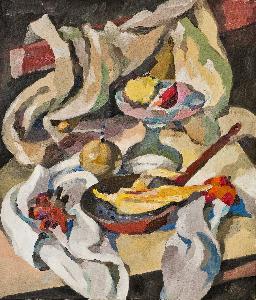Claudio Spattini
Claudio Spattini;Spattini
Place: Modena
Born: 1922
Death: 2010
Biography:
Claudio Spattini was an Italian painter born on July 18, 1922, in Modena, Italy. He studied at the Istituto d'Arte "Adolfo Venturi" in his hometown under the guidance of Arcangelo Salvarani and Renzo Ghiozzi. In 1939, he received his first national recognition with the Premio "Giovani", a prestigious art award in Italy. Spattini's work is characterized by its exploration of various styles within figurative Italian art throughout the 20th century.
Early Life and Education
Spattini's early life and education played a significant role in shaping his artistic style. He was born into a family of artists and was encouraged to pursue his passion for painting from a young age. His studies at the Istituto d'Arte "Adolfo Venturi" provided him with a solid foundation in traditional Italian art, which he later expanded upon through his own unique style.
Artistic Style and Influences
Spattini's work is notable for its blend of traditional and modern elements. He was influenced by the works of various artists, including Giovanni Battista Tiepolo and Vincent Van Gogh. His use of color and light is reminiscent of the Rococo style, while his attention to detail and composition is characteristic of the Early Renaissance period.
Notable Works and Exhibitions
Some of Spattini's notable works include "Neptune Offering Gifts to Venice", which showcases his mastery of mythological subjects, and "The Rape of Europa", which demonstrates his ability to capture the essence of classical themes. His work has been exhibited in various museums, including the Museo della Consolazione in Altomonte, Italy, and the Palazzo Vescovile in Pienza, Italy.
- Some of his notable works can be found on https://Wikioo.org/@@/A@D3ASS5-The-Museum-Museo-della-Consolazione-(Altomonte-Italy)
- His biography and artworks are also available on https://Wikioo.org/@/Claudio-Spattini
- More information about his style and influences can be found on https://Wikioo.org/Art.nsf/O/A@D3BDX7
Spattini passed away on October 27, 2010, in Parma, Italy, leaving behind a legacy of beautiful and thought-provoking works of art. His contributions to the world of Italian art are immeasurable, and his paintings continue to inspire artists and art lovers alike. For more information about Claudio Spattini and his artworks, visit https://Wikioo.org/@/Claudio-Spattini or Wikipedia.org.

